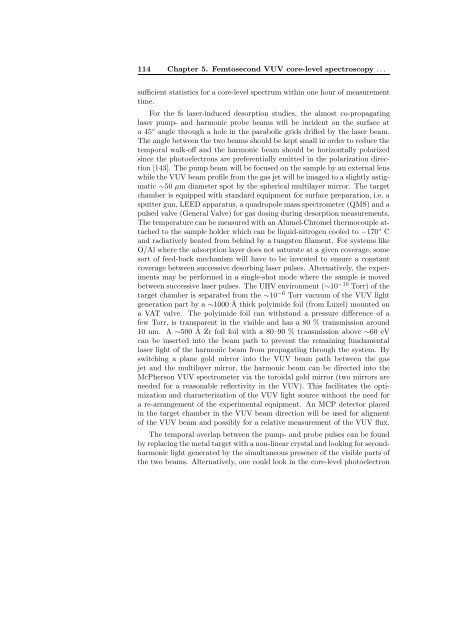VUV Spectroscopy of Atoms, Molecules and Surfaces
VUV Spectroscopy of Atoms, Molecules and Surfaces
VUV Spectroscopy of Atoms, Molecules and Surfaces
You also want an ePaper? Increase the reach of your titles
YUMPU automatically turns print PDFs into web optimized ePapers that Google loves.
114 Chapter 5. Femtosecond <strong>VUV</strong> core-level spectroscopy ...<br />
sufficient statistics for a core-level spectrum within one hour <strong>of</strong> measurement<br />
time.<br />
For the fs laser-induced desorption studies, the almost co-propagating<br />
laser pump- <strong>and</strong> harmonic probe beams will be incident on the surface at<br />
a45◦ angle through a hole in the parabolic grids drilled by the laser beam.<br />
The angle between the two beams should be kept small in order to reduce the<br />
temporal walk-<strong>of</strong>f <strong>and</strong> the harmonic beam should be horizontally polarized<br />
since the photoelectrons are preferentially emitted in the polarization direction<br />
[143]. The pump beam will be focused on the sample by an external lens<br />
while the <strong>VUV</strong> beam pr<strong>of</strong>ile from the gas jet will be imaged to a slightly astigmatic<br />
∼50 µm diameter spot by the spherical multilayer mirror. The target<br />
chamber is equipped with st<strong>and</strong>ard equipment for surface preparation, i.e. a<br />
sputter gun, LEED apparatus, a quadropole mass spectrometer (QMS) <strong>and</strong> a<br />
pulsed valve (General Valve) for gas dosing during desorption measurements.<br />
The temperature can be measured with an Alumel-Chromel thermocouple attached<br />
to the sample holder which can be liquid-nitrogen cooled to −170◦ C<br />
<strong>and</strong> radiatively heated from behind by a tungsten filament. For systems like<br />
O/Al where the adsorption layer does not saturate at a given coverage, some<br />
sort <strong>of</strong> feed-back mechanism will have to be invented to ensure a constant<br />
coverage between successive desorbing laser pulses. Alternatively, the experiments<br />
may be performed in a single-shot mode where the sample is moved<br />
between successive laser pulses. The UHV environment (∼10−10 Torr) <strong>of</strong> the<br />
target chamber is separated from the ∼10−6 Torr vacuum <strong>of</strong> the <strong>VUV</strong> light<br />
generation part by a ∼1000 ˚A thick polyimide foil (from Luxel) mounted on<br />
a VAT valve. The polyimide foil can withst<strong>and</strong> a pressure difference <strong>of</strong> a<br />
few Torr, is transparent in the visible <strong>and</strong> has a 80 % transmission around<br />
10 nm. A ∼500 ˚A Zr foil foil with a 80–90 % transmission above ∼60 eV<br />
can be inserted into the beam path to prevent the remaining fundamental<br />
laser light <strong>of</strong> the harmonic beam from propagating through the system. By<br />
switching a plane gold mirror into the <strong>VUV</strong> beam path between the gas<br />
jet <strong>and</strong> the multilayer mirror, the harmonic beam can be directed into the<br />
McPherson <strong>VUV</strong> spectrometer via the toroidal gold mirror (two mirrors are<br />
needed for a reasonable reflectivity in the <strong>VUV</strong>). This facilitates the optimization<br />
<strong>and</strong> characterization <strong>of</strong> the <strong>VUV</strong> light source without the need for<br />
a re-arrangement <strong>of</strong> the experimental equipment. An MCP detector placed<br />
in the target chamber in the <strong>VUV</strong> beam direction will be used for aligment<br />
<strong>of</strong> the <strong>VUV</strong> beam <strong>and</strong> possibly for a relative measurement <strong>of</strong> the <strong>VUV</strong> flux.<br />
The temporal overlap between the pump- <strong>and</strong> probe pulses can be found<br />
by replacing the metal target with a non-linear crystal <strong>and</strong> looking for secondharmonic<br />
light generated by the simultaneous presence <strong>of</strong> the visible parts <strong>of</strong><br />
the two beams. Alternatively, one could look in the core-level photoelectron















